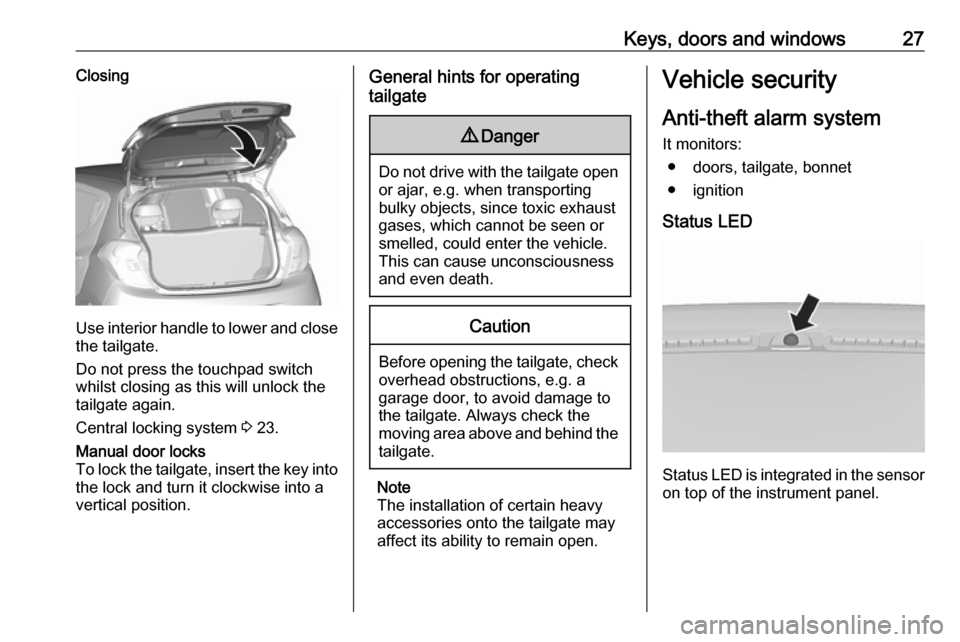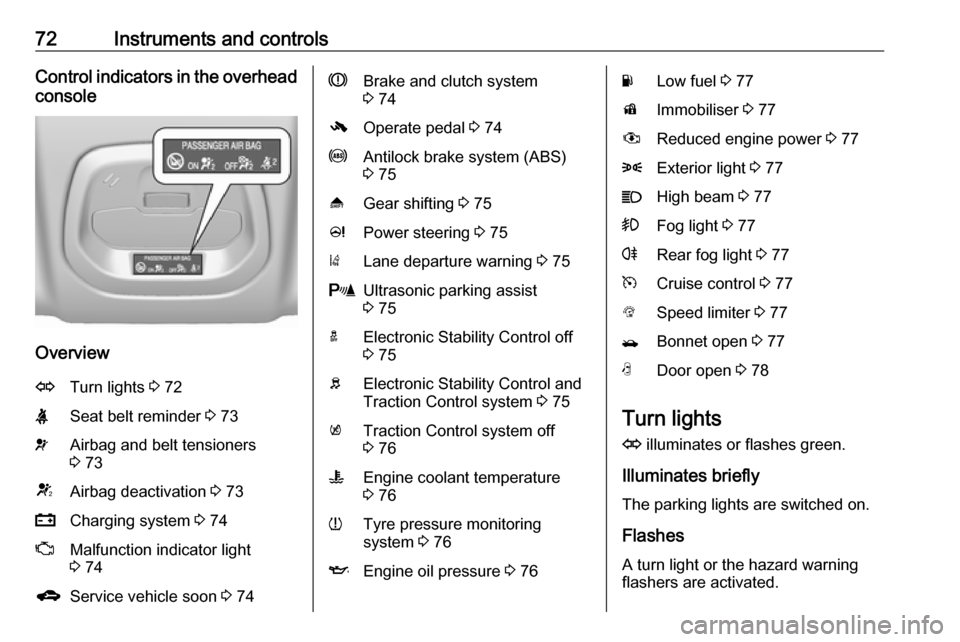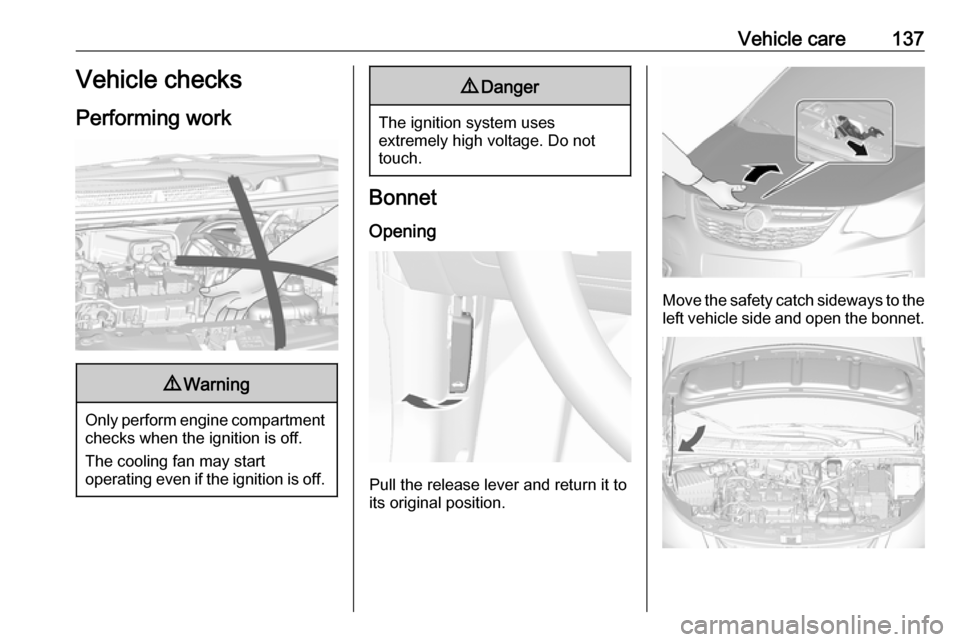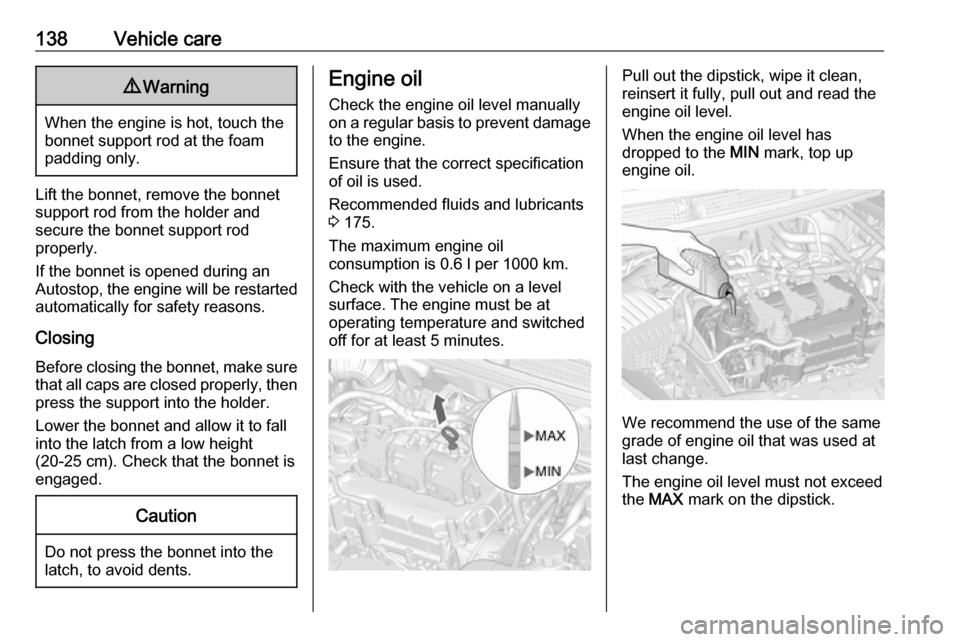open bonnet OPEL KARL 2018.5 Owner's Manual
[x] Cancel search | Manufacturer: OPEL, Model Year: 2018.5, Model line: KARL, Model: OPEL KARL 2018.5Pages: 203, PDF Size: 5.64 MB
Page 29 of 203

Keys, doors and windows27Closing
Use interior handle to lower and closethe tailgate.
Do not press the touchpad switch
whilst closing as this will unlock the
tailgate again.
Central locking system 3 23.
Manual door locks
To lock the tailgate, insert the key into
the lock and turn it clockwise into a
vertical position.General hints for operating
tailgate9 Danger
Do not drive with the tailgate open
or ajar, e.g. when transporting
bulky objects, since toxic exhaust
gases, which cannot be seen or
smelled, could enter the vehicle.
This can cause unconsciousness
and even death.
Caution
Before opening the tailgate, check overhead obstructions, e.g. a
garage door, to avoid damage to
the tailgate. Always check the
moving area above and behind the
tailgate.
Note
The installation of certain heavy
accessories onto the tailgate may
affect its ability to remain open.
Vehicle security
Anti-theft alarm system It monitors: ● doors, tailgate, bonnet
● ignition
Status LED
Status LED is integrated in the sensor
on top of the instrument panel.
Page 62 of 203

60Instruments and controlsInstruments and
controlsControls ....................................... 61
Steering wheel adjustment ........61
Steering wheel controls .............61
Heated steering wheel ...............61
Horn ........................................... 62
Windscreen wiper and washer ..62
Rear window wiper and washer ...................................... 63
Outside temperature ..................63
Clock ......................................... 63
Power outlets ............................. 65
Cigarette lighter ......................... 65
Ashtrays .................................... 65
Warning lights, gauges and indi‐ cators ........................................... 65
Instrument cluster ......................65
Speedometer ............................. 65
Odometer .................................. 66
Trip odometer ............................ 66
Tachometer ............................... 66
Fuel gauge ................................ 66
Fuel selector .............................. 67
Engine coolant temperature gauge ....................................... 68Service display.......................... 69
Control indicators ......................70
Turn lights .................................. 72
Seat belt reminder .....................73
Airbag and belt tensioners .........73
Airbag deactivation ....................73
Charging system .......................74
Malfunction indicator light ..........74
Service vehicle soon .................74
Brake and clutch system ...........74
Operate pedal ............................ 74
Antilock brake system (ABS) .....75
Gear shifting .............................. 75
Power steering .......................... 75
Lane departure warning ............75
Ultrasonic parking assist ...........75
Electronic Stability Control off ...75
Electronic Stability Control and Traction Control system ...........75
Traction Control system off .......76
Engine coolant temperature ......76
Tyre pressure monitoring system ...................................... 76
Engine oil pressure ....................76
Low fuel ..................................... 77
Immobiliser ................................ 77
Reduced engine power .............77
Exterior light .............................. 77
High beam ................................. 77
Fog light ..................................... 77Rear fog light............................. 77
Cruise control ............................ 77
Speed limiter ............................. 77
Bonnet open .............................. 77
Door open .................................. 78
Displays ....................................... 78
Driver Information Centre ..........78
Info Display ................................ 83
Vehicle messages ........................84
Warning chimes .........................86
Battery voltage .......................... 86
Vehicle personalisation ................87
Telematics service .......................89
OnStar ....................................... 89
Page 74 of 203

72Instruments and controlsControl indicators in the overhead
console
Overview
OTurn lights 3 72XSeat belt reminder 3 73vAirbag and belt tensioners
3 73VAirbag deactivation 3 73pCharging system 3 74ZMalfunction indicator light
3 74gService vehicle soon 3 74RBrake and clutch system
3 74-Operate pedal 3 74uAntilock brake system (ABS)
3 75[Gear shifting 3 75cPower steering 3 75)Lane departure warning 3 75rUltrasonic parking assist
3 75aElectronic Stability Control off
3 75bElectronic Stability Control and
Traction Control system 3 75kTraction Control system off
3 76WEngine coolant temperature
3 76wTyre pressure monitoring
system 3 76IEngine oil pressure 3 76YLow fuel 3 77dImmobiliser 3 77#Reduced engine power 3 778Exterior light 3 77CHigh beam 3 77>Fog light 3 77rRear fog light 3 77mCruise control 3 77LSpeed limiter 3 77/Bonnet open 3 77NDoor open 3 78
Turn lights
O illuminates or flashes green.
Illuminates briefly The parking lights are switched on.
Flashes
A turn light or the hazard warning flashers are activated.
Page 79 of 203

Instruments and controls779Warning
When the engine is off,
considerably more force is needed
to brake and steer.
During an Autostop, the brake
servo unit will still be operational.
Do not remove key until vehicle is stationary, otherwise the steeringwheel lock could engage
unexpectedly.
Check oil level before seeking the
assistance of a workshop 3 138.
Low fuel
Y illuminates or flashes yellow.
Illuminates
Level in fuel tank is too low.
Flashes
Fuel used up. Refuel immediately.
Never run the fuel tank dry.
Refuelling 3 131.
Catalytic converter 3 115.
Immobiliser
d flashes yellow.
Fault in the immobiliser system. The
engine cannot be started.
Immobiliser 3 28.
Reduced engine power
# illuminates yellow.
The engine power is limited. Consult
a workshop.
Exterior light8 illuminates green.
The exterior lights are on 3 94.
High beam
C illuminates blue.
Illuminated when high beam is on or during headlight flash 3 94.
Fog light > illuminates green.
The front fog lights are on 3 96.Rear fog light
r illuminates yellow.
The rear fog light is on 3 96.
Cruise control
m illuminates white or green.
Illuminates white The system is on.
Illuminates green
Cruise control is active.
Cruise control 3 124.
Speed limiter
L illuminates in the Driver
Information Centre when Speed
limiter is active. Set speed is indicated
alongside L symbol.
Speed limiter 3 125.
Bonnet open / illuminates yellow.
Illuminates when the bonnet is open.
Stop-start system 3 111.
Page 115 of 203

Driving and operating113● The brake vacuum is sufficient.
● The vehicle was driven at least at
walking speed since the last
Autostop.
Otherwise an Autostop will be
inhibited.
Certain settings of the climate control
system may inhibit an Autostop. See
"Climate control" chapter for further information 3 103.
Immediately after motorway driving
an Autostop may be inhibited.
New vehicle running-in 3 109.
Vehicle battery discharge protection
To ensure reliable engine restarts,
several vehicle battery discharge
protection features are implemented
as part of the stop-start system.
Power saving measures
During an Autostop, several electrical
features, e.g., the rear window
heating, are disabled or switched into
a power saving mode. The fan speed of the climate control system is
reduced to save power.Restart of the engine by the driverVehicles with manual transmission
Depress the clutch pedal to restart the
engine.
If the selector lever is shifted out of
neutral before depressing the clutch
pedal first, control indicator -
illuminates or is shown as a symbol in the Driver Information Centre.
Control indicator - 3 74.Vehicles with manual transmission
automated
Release the brake pedal or move
selector lever out of D to restart the
engine.
Restart of the engine by the stop-
start system
The selector lever must be in neutral
to enable an automatic restart.
If one of the following conditions
occurs during an Autostop, the
engine will be restarted automatically
by the stop-start system:
● The stop-start system is manually deactivated.
● The bonnet is opened.
● The driver's seat belt is unfastened and the driver's door
is opened.
● The engine temperature is too low.
● The charging level of the vehicle battery is below a defined level.
● The brake vacuum is not sufficient.
● The vehicle is driven at least at walking speed.
● The climate control system requests an engine start.
● The air conditioning is manually switched on.
If the bonnet is not fully closed, a warning message is displayed in the
Driver Information Centre.
If an electrical accessory, e.g. a
portable CD player, is connected to
the power outlet, a brief power drop
during restart might be noticeable.
Page 138 of 203

136Vehicle careCaution
When transporting the vehicle on
a train or on a recovery vehicle, the
mud flaps might be damaged.
Vehicle storage
Storage for a long period of time
If the vehicle is to be stored for several months:
● Wash and wax the vehicle.
● Have the wax in the engine compartment and underbody
checked.
● Clean and preserve the rubber seals.
● Fill up fuel tank completely.
● Change the engine oil.
● Drain the washer fluid reservoir.
● Check the coolant antifreeze and
corrosion protection.
● Adjust tyre pressure to the value specified for full load.
● Park the vehicle in a dry, wellventilated place. Engage first or
reverse gear. Prevent the vehicle from rolling.
● Do not apply the parking brake.
● Open the bonnet, close all doors and lock the vehicle.
● Disconnect the clamp from the negative terminal of the vehicle
battery. Beware that all systems are not functional, e.g. anti-theft
alarm system.
Putting back into operation When the vehicle is to be put back into
operation:
● Connect the clamp to the negative terminal of the vehicle
battery. Activate the electronics
of the power windows.
● Check tyre pressure.
● Fill up the washer fluid reservoir.
● Check the engine oil level.
● Check the coolant level.
● Fit the number plate if necessary.End-of-life vehicle recovery
Information on end-of-life vehicle
recovery centres and the recycling of
end-of-life vehicles is available on our
website. Only entrust this work to an
authorised recycling centre.
Gas vehicles must be recycled by a
service centre authorised for gas
vehicles.
Page 139 of 203

Vehicle care137Vehicle checks
Performing work9 Warning
Only perform engine compartment
checks when the ignition is off.
The cooling fan may start
operating even if the ignition is off.
9 Danger
The ignition system uses
extremely high voltage. Do not
touch.
Bonnet
Opening
Pull the release lever and return it to
its original position.
Move the safety catch sideways to the left vehicle side and open the bonnet.
Page 140 of 203

138Vehicle care9Warning
When the engine is hot, touch the
bonnet support rod at the foam
padding only.
Lift the bonnet, remove the bonnet
support rod from the holder and
secure the bonnet support rod
properly.
If the bonnet is opened during an
Autostop, the engine will be restarted automatically for safety reasons.
Closing
Before closing the bonnet, make sure that all caps are closed properly, then
press the support into the holder.
Lower the bonnet and allow it to fall
into the latch from a low height
(20-25 cm). Check that the bonnet is
engaged.
Caution
Do not press the bonnet into the
latch, to avoid dents.
Engine oil
Check the engine oil level manually
on a regular basis to prevent damage
to the engine.
Ensure that the correct specification
of oil is used.
Recommended fluids and lubricants
3 175.
The maximum engine oil
consumption is 0.6 l per 1000 km.
Check with the vehicle on a level
surface. The engine must be at
operating temperature and switched
off for at least 5 minutes.Pull out the dipstick, wipe it clean,
reinsert it fully, pull out and read the
engine oil level.
When the engine oil level has
dropped to the MIN mark, top up
engine oil.
We recommend the use of the same
grade of engine oil that was used at
last change.
The engine oil level must not exceed
the MAX mark on the dipstick.
Page 173 of 203

Vehicle care171If using a car wash, comply with the
car wash manufacturer's instructions.
The windscreen wiper and rear
window wiper must be switched off.
Remove antenna and external
accessories such as roof racks etc.
If you wash your vehicle by hand,
make sure that the insides of the
wheel housings are also thoroughly
rinsed out.
Clean edges and folds on opened
doors and the bonnet as well as the
areas they cover.
Clean bright metal mouldings with a
cleaning solution approved for
aluminium to avoid damages.Caution
Always use a cleaning agent with
a pH value of four to nine.
Do not use cleaning agents on hot surfaces.
Have the door hinges of all doors
greased by a workshop.
Do not clean the engine compartment with a steam-jet or high-pressure jet
cleaner.
Thoroughly rinse and leather-off the vehicle. Rinse leather frequently. Use
separate leathers for painted and
glass surfaces: remnants of wax on
the windows will impair vision.
Do not use hard objects to remove
spots of tar. Use tar removal spray on
painted surfaces.
Exterior lights
Headlight and other light covers are
made of plastic. Do not use any
abrasive or caustic agents, do not use
an ice scraper, and do not clean them
dry.
Polishing and waxing
Wax painted parts of the vehicle
regularly (at the latest when water no longer beads). Otherwise, the
paintwork will dry out.
Polishing is necessary only if the paint
has become dull or if solid deposits
have become attached to it.
Paintwork polish with silicone forms a
protective film, making waxing
unnecessary.Unpainted plastic body parts must not
be treated with wax or polishing
agents.
Windows and windscreen wiper
blades
Use a soft lint-free cloth or chamois
leather together with window cleaner and insect remover.
When cleaning the rear window from
inside, always wipe in parallel to the
heating element to prevent damage.
For mechanical removal of ice, use a
sharp-edged ice scraper. Press the
scraper firmly against the glass so
that no dirt can get under it and
scratch the glass.
Clean smearing wiper blades with a
soft cloth and window cleaner.
Sunroof
Never clean with solvents or abrasive agents, fuels, aggressive media (e.g.
paint cleaner, acetone-containing
solutions etc.), acidic or highly
alkaline media or abrasive pads. Do
not apply wax or polishing agents to
the sunroof.
Page 198 of 203

196IndexAAccessories and vehicle modifications .......................... 135
Adjustable air vents ...................106
Airbag and belt tensioners ...........73
Airbag deactivation ................46, 73
Airbag label................................... 41 Airbag system .............................. 41
Air conditioning regular operation ................................ 107
Air conditioning system .............. 101
Air intake .................................... 107
Air vents...................................... 106
Antilock brake system ................ 119
Antilock brake system (ABS) .......75
Anti-theft alarm system ................27
Appearance care ........................170
Ashtrays ....................................... 65
Autostop ..................................... 111
B Battery discharge protection ........99
Battery voltage ............................. 86
Belts.............................................. 39
Bonnet ....................................... 137
Bonnet open ................................. 77
Brake and clutch fluid .................175
Brake and clutch system .............74
Brake assist ............................... 120
Brake fluid .................................. 140Brakes ............................... 119, 140
Breakdown.................................. 169
Bulb replacement ....................... 143
C Capacities .................................. 185
Catalytic converter .....................115
Central locking system ................23
Centre console storage ...............54
Centre high-mounted brake light 147
Changing tyre and wheel size ...159
Charging system .......................... 74
Child locks ................................... 25
Child restraint installation locations ................................... 50
Child restraints.............................. 47
Child restraint systems ................47
Cigarette lighter ........................... 65
City mode ................................... 123
Climate control ............................. 17
Climate control systems .............100
Clock ............................................ 63
Code ............................................. 84
Control indicators.......................... 70
Control of the vehicle .................108
Controls ........................................ 61
Coolant and antifreeze ...............175
Cornering lights ............................ 95
Cruise control ...................... 77, 124